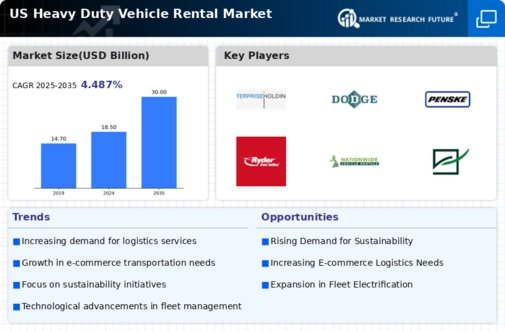The heavy duty-vehicle-rental market is characterized by a competitive landscape that is increasingly shaped by innovation, sustainability, and digital transformation. Key players such as United Rentals (US), Ryder System (US), and Penske Corporation (US) are actively pursuing strategies that enhance their operational efficiency and market reach. United Rentals (US) has positioned itself as a leader through a focus on expanding its fleet with advanced technology, while Ryder System (US) emphasizes supply chain optimization and customer-centric solutions. Penske Corporation (US) appears to be leveraging strategic partnerships to enhance its service offerings, collectively contributing to a dynamic competitive environment that prioritizes technological advancement and customer satisfaction.
In terms of business tactics, companies are increasingly localizing their operations to better serve regional markets, which may enhance responsiveness and reduce logistics costs. The market structure is moderately fragmented, with several key players exerting influence over various segments. This fragmentation allows for niche players to thrive, while larger companies consolidate their market positions through strategic acquisitions and partnerships, thereby shaping the competitive dynamics.
In October 2025, United Rentals (US) announced a significant investment in electric vehicle technology, aiming to expand its electric heavy-duty vehicle rental options. This move not only aligns with the growing demand for sustainable solutions but also positions the company as a forward-thinking leader in the market. The strategic importance of this investment lies in its potential to attract environmentally conscious customers and reduce operational costs associated with traditional fuel sources.
In September 2025, Ryder System (US) launched a new digital platform designed to streamline the rental process for heavy-duty vehicles. This platform integrates advanced analytics and AI to enhance customer experience and operational efficiency. The strategic significance of this initiative is profound, as it reflects a broader trend towards digitalization in the rental market, potentially setting a new standard for customer engagement and service delivery.
In August 2025, Penske Corporation (US) entered into a partnership with a leading telematics provider to enhance its fleet management capabilities. This collaboration aims to leverage data analytics for improved vehicle tracking and maintenance scheduling. The strategic implications of this partnership are noteworthy, as it underscores the importance of technology in optimizing fleet operations and reducing downtime, thereby enhancing overall service reliability.
As of November 2025, the competitive trends in the heavy duty-vehicle-rental market are increasingly defined by digitalization, sustainability, and the integration of AI technologies. Strategic alliances are becoming a cornerstone of competitive differentiation, allowing companies to pool resources and expertise. Looking ahead, it is likely that the focus will shift from traditional price-based competition to a landscape where innovation, technological advancement, and supply chain reliability become the primary differentiators. This evolution suggests that companies must adapt to changing market demands and invest in sustainable practices to maintain a competitive edge.



















Leave a Comment